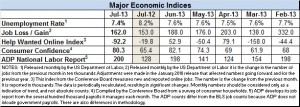 Temp hiring slowed in July, offering little lift to a lackluster hiring month, that came in well below what economists and the markets were expecting.
Temp hiring slowed in July, offering little lift to a lackluster hiring month, that came in well below what economists and the markets were expecting.
No sector of the economy showed much hiring energy as the Labor Department’s overall count of non-farm employment during the month came in at 162,000 new jobs, well below the 185,000 jobs that had been expected.
Neither the staffing industry nor healthcare — two of the consistent growth areas now for many months — added many workers; 7,700 for the former and 8,300 for the latter.
For the staffing industry, it was the slowest increase since September 2012 when 12,600 temp jobs were cut. This year, through June, the average monthly increase in temp jobs was 20,400.
Were it not for the reduction in the unemployment rate, which dropped from 7.6% in June to 7.4%, its lowest in almost five years, the report would have been completely disappointing indeed. Besides the below-expectation job growth, the Labor Department:
- Revised downward its counts for both May and June, cutting 26,000 jobs from the previously robust numbers;
- Said the average hourly wage for all non-farm workers declined by 2 cents an hour, after rising 10 cents in June. The increase since July 2012 is 1.9%.
- Reported that the average weekly hours for all workers declined by .1 hour to 34.4; for manufacturing workers it dropped .2 hour to 40.6 hours.
“This isn’t a disaster of a report but it shows the U.S. remains vulnerable to a slower economic growth performance,” said Julia Coronado, chief economist for North America at BNP Paribas in New York.
SHRM’s LINE report this week, which attempts to predict hiring demand for the month ahead, says August is likely to be positive. “In August, half of manufacturers and more than one-third of service-sector companies will conduct hiring,” says the report, which calls August hiring rates “strong.”
In the Labor Department’s July report, the few bright spots were in retail, up by 47,000 jobs, and in the leisure and hospitality sector where bars and restaurants grew by 38,000. Both those sectors however, have the lowest average wage, and, in the leisure area, almost 40% of that gain was wiped out by job losses in hotels and motels, sports and performing arts, and related areas.
Another, and somewhat surprising growth area was the financial sector. The securities industry added 5,600 jobs in July, a demonstration of Wall Street’s growing confidence and strength after several years of job losses. The broader financial activities sector, which includes Wall Street, accounting, insurance, real estate and similar industries, grew by 15,000 jobs.
Manufacturing, which tends to seesaw more than most other sectors, added 6,000 jobs, which were offset by an equivalent number in the construction industry, which was a huge job loser in the recession.
The reduction in the unemployment rate was at least one positive without an offsetting “but.” It represented a genuine reduction in the number of unemployed workers, who declined by some 260,000 to 11.5 million in July. A year ago, 12.7 million people were counted as out of work.
Those working part time because they can’t find full time jobs was unchanged at 8.2 million and another 2.4 million are out of work, but not officially counted as unemployed. Together, these so-called U-6 unemployed come to 14 million, down 900,000 from a year ago.